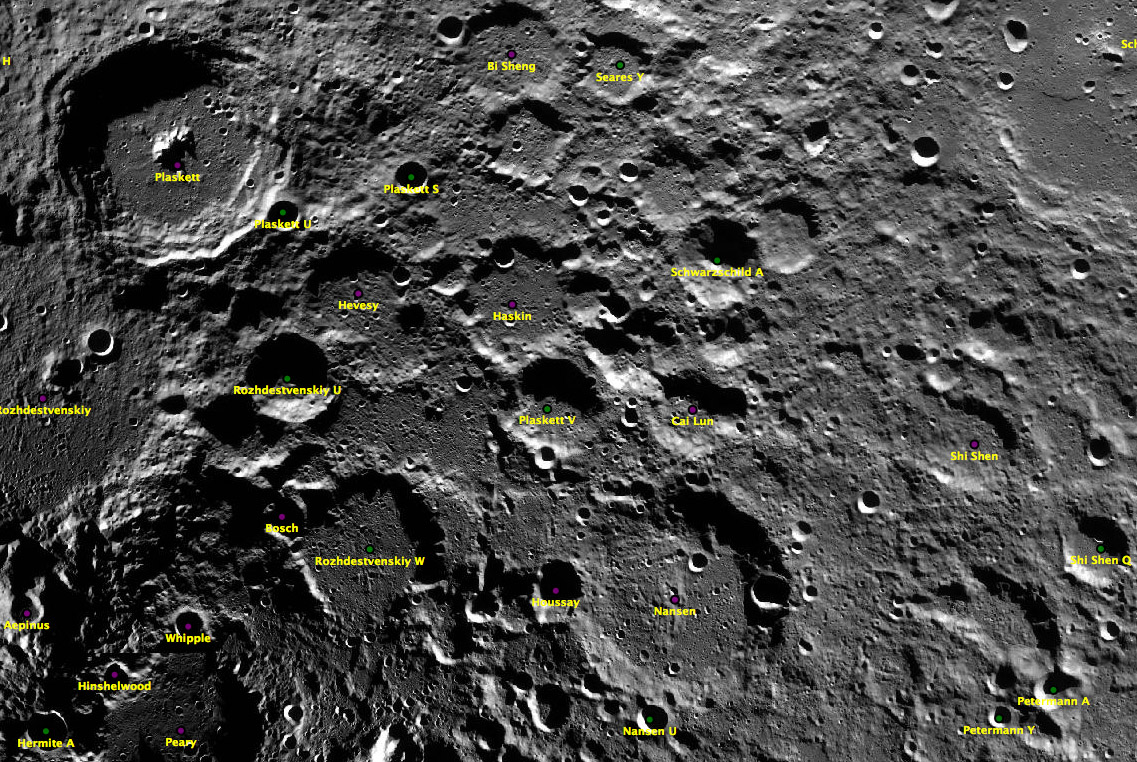Difference between revisions of "June 26, 2012"
| (One intermediate revision by the same user not shown) | |||
| Line 6: | Line 6: | ||
<em>image from [http://target.lroc.asu.edu/da/qmap.html LRO QuickMap]</em><br /> | <em>image from [http://target.lroc.asu.edu/da/qmap.html LRO QuickMap]</em><br /> | ||
<br /> | <br /> | ||
| − | Many new discoveries are coming fast and furious so today we hop back to the LPOD of [http://lpod. | + | Many new discoveries are coming fast and furious so today we hop back to the LPOD of [http://www2.lpod.org/wiki/June_24,_2012 June 24] |
| − | and tomorrow we will provide new information about the [http://lpod. | + | and tomorrow we will provide new information about the [http://www2.lpod.org/wiki/June_23,_2012 June 23] LPOD. And then after that we will |
get back to new new discoveries. The LPOD of two days ago concerned the half crater southeast | get back to new new discoveries. The LPOD of two days ago concerned the half crater southeast | ||
of Nansen, seen here near the bottom right between Shi Shen and Petermann A. I speculated that | of Nansen, seen here near the bottom right between Shi Shen and Petermann A. I speculated that | ||
the missing half of this feature could be buried under nearly 2 km depth of basin ejecta, probably | the missing half of this feature could be buried under nearly 2 km depth of basin ejecta, probably | ||
from Humboldtianum if this conjecture was right. But I ended with suggestions that other evidence | from Humboldtianum if this conjecture was right. But I ended with suggestions that other evidence | ||
| − | argued against that source. Here is <em>that</em> evidence. Notice Nansen (which we recently [http://lpod. | + | argued against that source. Here is <em>that</em> evidence. Notice Nansen (which we recently [http://www2.lpod.org/wiki/June_11,_2012 saw] from an |
Earth perspective) has part of its floor covered by rough textured material similar to what is in the | Earth perspective) has part of its floor covered by rough textured material similar to what is in the | ||
half crater. This material is about 1000 m thick near the left rim and thins to about 600 m before | half crater. This material is about 1000 m thick near the left rim and thins to about 600 m before | ||
| Line 34: | Line 34: | ||
<br /> | <br /> | ||
<strong>Related Links</strong><br /> | <strong>Related Links</strong><br /> | ||
| − | Rükl plate [https://the-moon.us/wiki/R%C3% | + | Rükl plate [https://the-moon.us/wiki/R%C3%BCkl_6 6]<br /> |
<br /> | <br /> | ||
<p><b>Yesterday's LPOD:</b> [[June 25, 2012|Mini-Schiller]] </p> | <p><b>Yesterday's LPOD:</b> [[June 25, 2012|Mini-Schiller]] </p> | ||
Latest revision as of 08:30, 28 October 2018
The Evidence Piles Up

image from LRO QuickMap
Many new discoveries are coming fast and furious so today we hop back to the LPOD of June 24
and tomorrow we will provide new information about the June 23 LPOD. And then after that we will
get back to new new discoveries. The LPOD of two days ago concerned the half crater southeast
of Nansen, seen here near the bottom right between Shi Shen and Petermann A. I speculated that
the missing half of this feature could be buried under nearly 2 km depth of basin ejecta, probably
from Humboldtianum if this conjecture was right. But I ended with suggestions that other evidence
argued against that source. Here is that evidence. Notice Nansen (which we recently saw from an
Earth perspective) has part of its floor covered by rough textured material similar to what is in the
half crater. This material is about 1000 m thick near the left rim and thins to about 600 m before
dropping precipitously to the crater floor. So this is some sort of fill that thickens away from the
proposed Humboldtianum source. It still might have come from there and somehow been piled up
against the rim and slid backwards. The next observation may not be relevant but there is a smooth
and flat plateau between Rozhdestvensky W and Nansen - I wonder if it is related to the fill in Nansen?
Finally, look at the upper right part of the rim of Plaskett. There seems to be a mound of material just
outside the rim that cascaded over the rim, burying the terraces and intruding a little on the crater's flat
floor. From the map tool on the LRO QuickMap you can see that this mound is 2-3 km high and has a
basal diameter of about 60 km. It seems to be similar material to the rough stuff seen elsewhere, and
it looks like it is on top of a relatively young crater. Plaskett was mapped by the USGS as Upper
Imbrian, and the putative ejecta source region, the Humboldtianum Basin, was considered Nectarian,
mappably older. If the basin didn't pile up the mound, which would be a strange way for ejecta to be
concentrated, what is its origin? I don't know - nothing else seems reasonable, perhaps it was a pre-existing local high spot that partially collapsed into the crater after it formed. That would be pretty rare
too. We eliminate multiple problems if we say all of this is basin ejecta and its deposition was too complex for us to completely understand 4 billion years later. Or we can be less satisfied, probably, by saying that the missing half crater, the sloping fill in Nansen and the pile on Plaskett have other, mysterious
origins. I am not pleased by either option, are you?
Chuck Wood
Related Links
Rükl plate 6
Yesterday's LPOD: Mini-Schiller
Tomorrow's LPOD: Blue Lava
COMMENTS?
Register, Log in, and join in the comments.



